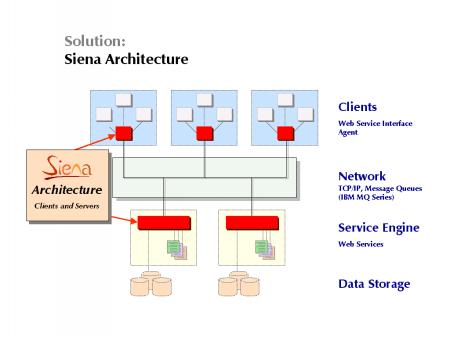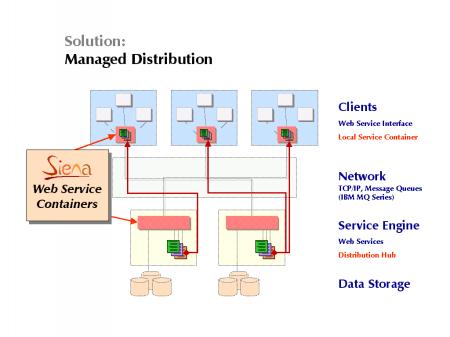Putting Web Services to Work with Python
| Category: | Software Development |
|---|---|
| Keywords: | Web Development, Web2.0 |
| Title: | Putting Web Services to Work with Python |
| Authors: | Dr Tim Couper and Marc-Andre Lemburg
Siena Technology Ltd. |
| Date: | 2003/01/17 15:59:01 |
| Website: | http://www.siena-tech.com/ |
| Summary: | The Siena Web Services Architecture brings Python productivity to enterprise Web services development. |
| Logo: | 
|
Introduction
Consultants naturally try to provide their customers with the best solutions for a problem. Sometimes this means exploring new areas together with the customer or directing the project into a solution space that better fits the problem than the usual "buzzword-compliant" approaches. We've seen these fail too often, misleading the project into solving problems relating to the selected technology, rather than meeting the original project plan.
Python Goes Fortune 500
In a recent project for one of our customers, we faced a problem that is quite common in Fortune 500 companies: Multiple clients running on unmanageable client machines are tied closely to complicated database relationships, making management and further development very difficult.
Thanks to the marketing efforts of several large server vendors, our solution space was quickly identified. What the company needed was "Web services", or put simply, a way for a client application to talk to the server side in a reasonably standardized manner. Our customer was already using two of the dominant technologies in this area: Microsoft's .NET and BEA's WebLogic J2EE server.
When we came into the project, a team was already trying to solve some of the company's problems using the J2EE platform. However, we found that they were spending more time trying to work around design problems in the technology than actually writing code for the services. Since the company had already been introduced to Python in a smaller XML project, we were able to convince the project lead to try a new technique based on Python.
The idea was to leverage the efficiency of Python programming together with its good database connectivity to compete against the J2EE team. What we needed was a stable and robust server implementation and a flexible way to write and publish Web services. Fortunately, the server had already been written in the form of the easily extensible eGenix.com Application Server, so our task was simply one of adapting this server to make writing services as easy as possible.
Keep IT Simple But No Simpler (KISS)
Following the Python paradigm of "obvious is better than obscure, explicit is better than implicit," we chose the most straight forward possible way of dealing with Web services: Each service was mapped to a Python class, which provided the public methods to call from the client application. There were two reason that we felt that service implementations should look no different than any standard class implementation in Python for two reasons: (1) a programmer should not need to learn a new way of coding just to be able to write services, and (2) existing integrated development environments (IDEs) should be used to make coding services even easier.
Since Python is an object-oriented programming (OOP) language in all respects, the implementation we chose placed basic shared functionality into a Service base class that hides networked server interaction from the programmer. As a result, the service developer only needs to think about the business logic in the service methods and can rely on the server to automatically provide database connection pooling, protocol handling, transaction control, and all the complicated interactions that are needed to make a server side implementation robust.
Client-Side Bliss
Another design goal for the system was to simplify client-side programming as much as possible, in order to make it easy to adopt the new technique. Just as service writers shouldn't need to think about low-level database connectivity, we felt that client application programmers shouldn't be bothered with the details of setting up connections and talking to the server side. We wanted to design a very simple application programmer's interface (API) which would hide all the complications inherent to networked client/server interaction.
Client side agents for Java and Windows' COM interface made this possible by enabling access to the Web services from all major client application environments such as Visual Basic (VB), Visual Basic for Applications (VBA as used in Word, Excel, and Access), Delphi, C++, Java, C# and others. These not only hide the protocol level from the application programmer, but also provide the key to enabling security and fail-over solutions.
Web services standards are still in the planning stage, and it is not at all clear which of the proposals will be accepted by standards organizations. By creating a true middle tier, we were able to hide the particular methods and protocols we chose inside of the Siena client and server, and were free to use existing security standards and authentication modes to build a secure communication channel.

The Siena Web Services Architecture Zoom in
Above and Beyond Web Services
With these basic building blocks, we were moving towards realizing the Siena Web Services Architecture, which included a Python-based server side, a COM client side agent (also written in Python), and a Java client side agent.
One distinct advantage of writing both the server side and COM client side of our Web services architecture in Python was that we could automatically replicate services from the server to the client side. This was possible whenever a service did not depend on database connectivity or other elements specific to the server-side environment. Python's data packaging facilities and portable byte code format made this operation quite easy to implement. The result was a significant boost in application performance, reduced network bandwidth requirements, reduced network latency, and increased server performance, all without sacrificing the efficiency of centralized server-side management that makes Web services so attractive to IT management.

Managed client-side service replication with Siena Web Service Containers Zoom in
The Python Mantra
Still missing in our plan were the skills needed to code Python servers and clients. Most of the programmers in our team knew only a mix of Java, Visual Basic, and C++. While the J2EE group was working on solving J2EE problems, we invested a day in teaching Python to the rest of the team. Python wasted no time making its way into the hearts and minds of these programmers. It was a thrill to hear fellow programmers chiming in with our own Python mantra: "This is what I've always been looking for."
Results
Happy programmers are good programmers, and good programmers work efficiently. That's what project management learned at this point in our effort. The group's Web services programmers quickly caught onto the new Python-based system and development progressed at amazing speed. Services could now be implemented in a few minutes rather than the days needed using the typical J2EE approach. Now most services were completed and deployed in less than a day, and the ease and speed with which they can be modified and tested has made an incremental approach to service development possible. And IT management was excited to see the overall high performance of our solution.
The Siena Web Services Architecture has become a crucial mission-critical component for this customer, as it moves from a two tier to three tier architecture and adds fail-over and security to their Web services.
The Siena Web Services Architecture will soon become part of our product line. If you are interested in the solution, please visit our web-site at http://www.siena-tech.com/ or contact us directly.
PS: After several months of effort, the J2EE team never did get their Web services working.
About the Authors
Dr. Tim Couper (tim@siena-tech.com) is the chairman of Siena Technology. He holds a mathematics D.Phil. and has 20 years experience running software companies. He now spends most of his time consulting as architect and technical lead for large development projects, and has been extensively involved in planning and coordinating the 2002 and 2003 Python UK conferences.
Marc-Andre Lemburg (mal@siena-tech.com) is the Chief Technical Officer (CTO) of Siena Technology. He holds a degree in mathematics from the University of Duesseldorf. Marc-Andre has been working with Python since 1993, is a Python Core Developer, board member of the Python Software Foundation (PSF), author of the well-known eGenix.com mx extensions (mxODBC and mxDateTime), and was one of the executive organizers of EuroPython 2002.

